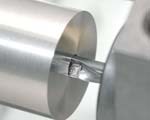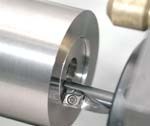Multifunctional Tool Brings Immediate Savings
What would it be worth to a shop to address a problem job in the morning and by afternoon, be running it 40 percent faster? That was exactly BVR Technologies’ (Rockford, Illinois) situation in regards to a standard carrier—a turned part they were machining on a regular basis.
What would it be worth to a shop to address a problem job in the morning and by afternoon, be running it 40 percent faster? That was exactly BVR Technologies’ (Rockford, Illinois) situation in regards to a standard carrier—a turned part they were machining on a regular basis. The part goes into a gear assembly, which was doubling in demand at the time. At the same time, the company was aggressively pursuing such manufacturing principles as Lean Manufacturing, Kanban and SMED (setup reduction). Therefore, naturally, the company’s process engineers were pulling out all the stops.
One Day Makes A Difference
BVR, part of the Esterline group of companies, manufactures a variety of motion control products for aerospace, avionics and medical uses. One morning, the company was machining the carrier in an eight-step sequence using six different conventional turning tools on a 9-year-old Hardinge T42 Conquest. Cycle time was 1 minute, 40 seconds. The parts, measuring 1.5 inches diameter by 0.25 inch thick, run in 200-piece lots once a month.
By the afternoon of that same day, the piece was being completed in only three steps in 1 minute, using a new breed of combination tools for lathes and automatics. The tool is Ingersoll’s T-Cap multifunctional tool, which drills, bores, turns and faces. Ingersoll Cutting Tool Co. (Rockford, Illinois) is among the first tooling companies to offer this style of tool. BVR became the first company to put Ingersoll’s new tool into regular service.
BVR’s manufacturing engineer Don Dusing targeted the carrier operation because he saw a lot of room for improvement and because many other company parts need the same basic processing. Mr. Dusing called Ingersoll’s Mike Crabtree, who had left a kick-off briefing on the T-Cap. “It seemed a perfect fit, and BVR happens to be only a few minutes down the road,” Mr. Crabtree says. “I drove right over with the only sample I had, and we tried it out.”
By 3 p.m. that day, the part was running 40 percent faster than before, and Rick Ruppert, manufacturing manager, could project further dramatic savings because of faster setup next time the job runs. “We’ll need to set just two tools in the turret rather than six. Reducing tool count exerts a lot of leverage in an operation like ours.”
Four In One
The new T-Cap combination tool works as four tools in one. It looks like an indexable drill with one insert on the face rather than the usual two. However, the geometry of the insert enables drilling (from solid), boring and also turning and facing. The entire front face is a cutting edge for drilling, and the outside corner works like a conventional turning and facing edge. Chipbreakers on both sides of the cutting edge are designed to deliver excellent chip control in both the drilling and turning/facing modes. To save setup time still further, the optional T-Cap clamping unit boasts a built-in center height adjustment.
The BVR case illustrates the accelerating rate of change in today’s metalworking. “The fact that we had a breakthrough tool is only half the story,” Mr. Crabtree says. “The real key is how quickly the company reacted and what they’ll gain competitively by being an early adopter of a new technology. No time lost kicking tires here.”
Making A Good Thing Better
BVR didn’t quit tweaking the operation after that first day. Together with Ingersoll’s Technology Center, they ran more tests to optimize the operation. Today, the part is run from a pre-hardened material, Rc32, which eliminates a heat treating step.
Because the T-Cap multifunctional tool is suited to other BVR work, Mr. Dusing leaves it in the turret for other jobs. This is projected to save at least 16 operator hours a year. “First, it’s one tool, not six, and it meets a lot of recurring needs,” says Mr. Ruppert. “Second, we don’t have to set it up with each new job.”
Looking over the company’s entire workload and where the T-Cap tool will fit, Mr. Ruppert projects total annual savings exceeding $10,000. Drilling, turning and boring small parts represents a hefty share of the company’s machining work, so the tool will be busy on a lot of jobs. “More important, we’ll be able to deliver sooner, handle shorter runs more efficiently and compete better,” he adds. “A tool like this helps us manage our growth. In today’s market, that’s priceless.”
Read Next
JIT Driving New Cutting Tool Solutions
It's increasingly rare that shops can use "set it" and "forget it" tooling schemes for screw machine production runs. Today's schedules require more frequent changeover. Quick-change cutting tools, coupled with more advanced tool materials, are helping shops remain productive and competitive.
Read MoreDo You Have Single Points of Failure?
Plans need to be in place before a catastrophic event occurs.
Read MoreEmerging Leaders Nominations Now Open
Here’s your chance to highlight a young person in your manufacturing business who is on the path to be a future leader moving your company forward.
Read More





















